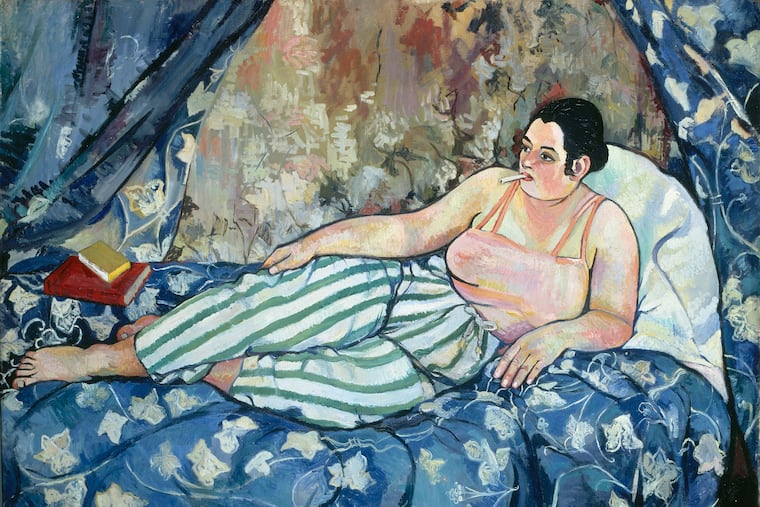Suzanne Valadon emerges as a masterly post-impressionist painter in new Barnes exhibition
She began as a model for many well known male artists, became a skilled painter and then suffered the decline of her reputation. In the 21st century, she's back.

With tongue decidedly in cheek, the anonymous group of feminist artists who call themselves the Guerrilla Girls, once compiled a list of “the advantages of being a woman artist.” Among the dubious rewards? “Being included in revised versions of art history.”
The extraordinary Suzanne Valadon (1865–1938), is a case in point. The Barnes Foundation’s “Suzanne Valadon: Model, Painter, Rebel,” the artist’s first major U.S. exhibition, constitutes a fresh appraisal of her importance as a French post-Impressionist.
Valadon, a self-taught painter who admired Paul Gauguin and counted Edgar Degas, Pierre-Auguste Renoir, and Henri de Toulouse-Lautrec as friends and mentors, is right at home at the Barnes. Happily, a ticket to the Valadon retrospective includes free access to the Barnes’ permanent collection, with its gracious plenty of paintings by her male counterparts.
Valadon grew up in Montmartre, a Bohemian quarter of Paris, as the only child of an impoverished single mother. An agile 15-year-old, she worked as a trapeze artist, a pursuit ended by a fall. She became a popular model for artists, grueling work that often required holding awkward poses for long periods of time.
It is as a model that curator Nancy Ireson introduces Valadon in the exhibition’s first gallery. As evidenced in work by a variety of artists, she was a game and versatile performer, who could transform herself into a sinuous siren, or a contorted gamine with an impish grin.
We catch a glimpse of Valadon as herself in two paintings by her then-lover Toulouse-Lautrec. She is physically present yet emotionally disengaged in his Portrait (1885), and in The Hangover (1887-88). It was Lautrec who jokingly nicknamed his model “Susanna,” the biblical beauty spied on by lecherous elders.
Valadon began to sketch as a girl and was encouraged to continue by the artists she knew. It was Degas who recognized “her genius for drawing,” in his words, and who taught her printmaking.
Valadon’s superb ability to render bodies with knowing contours and minimal interior shading is apparent in a group of early prints and drawings of lounging adolescents and women and children at bath time, sponging, toweling and stepping in and out of tubs. One memorable detail of a knock-kneed girl seen from behind, grappling with the dress fastening at the nape of her neck, evidences her fondness for uncommon viewpoints.
At 18, Valadon bore a son, Maurice Utrillo, whose paternity was never disclosed. She taught him to paint and supported him for years as she and her mother weathered his alcoholism and bouts of mental illness.
It would be Utrillo — not Valadon — who gained entry to the art historical canon and to Barnes’ collection, even though her art was well regarded during her lifetime.
In her life and in her art, Valadon rebelled against bourgeois niceties. She ceased modeling in 1896 after marrying a businessman who would divorce her a decade later when she fell in love with André Utter, an artist friend of Maurice’s, 21 years her junior.
Valadon’s joyful, audacious Adam and Eve (1909), full-frontal nude portraits of herself and Utter, was the first instance of such a painting by a female artist to be openly exhibited.
Utter likely posed for the nude figure in Valadon’s majestic Joy of Life (1911), an updated riff on the Judgement of Paris, the Greek myth of a beauty contest that serves as a paradigm of the male gaze.
He’s fully clothed in her tightly compressed, psychologically complex Family Portrait (1912). This unconventional household included Utter, her troubled son, and her elderly mother, a lifetime’s hardship etched on her face. Only the artist makes eye contact with viewers, as she does in her unflinching, nuanced Self-Portrait (1927), painted at age 62.
Perhaps the most celebrated work among the more than fifty on view is The Blue Room (1923).
Although the genealogy of her model’s reclining pose traces back to Manet and Titian, Valadon’s version is unlike her objectified, nude forebears. Dressed in a camisole and comfortable pants, she appears to have no interest in pleasing anyone but herself.
Step closer to The Blue Room to parse the irregular squalls of pinks, reds, blues, and greens laid side by side that signal three dimensionality in Valadon’s rendering of flesh. There are isolated portions of the background that unexpectedly read as abstractions.
The Violin Case (1923) is a masterwork with coded meanings and a panoply of visual treats. An ostensible still life, it is endowed with the sensual power Valadon granted her nudes.
Like a vault propped open to expose treasures hidden within, the blue velvet-lined sheath shelters an evocatively curved violin nestled into the plump folds of a blood-red cloth. Linear borders that rhyme and patches of curious patterns are two of the pleasures that reward close looking.
By lauding her “virile power” and “masculine force,” Valadon’s contemporary supporters shackled her with gender stereotypes masquerading as compliments. This dated practice survived well into the 20th century, when art teachers might praise a woman who “paints like a man.”
Painter Joan Semmel, born six years before Valadon died in 1938, may not have been aware of her predecessor when she was in art school. But Semmel’s nude self-portraits, and couples in intimate embrace (currently on view in her retrospective at the Pennsylvania Academy of the Fine Arts), are hard to imagine without the boundary-busting precedents of Suzanne Valadon.
“Suzanne Valadon: Model, Painter, Rebel” runs through Jan. 9. The exhibition is included with admission to the Barnes Foundation, adults, $25; seniors, $23; students, $5. The museum is closed Tuesday and Wednesday, open Thursday through Monday, 11 a.m. to 5 p.m.